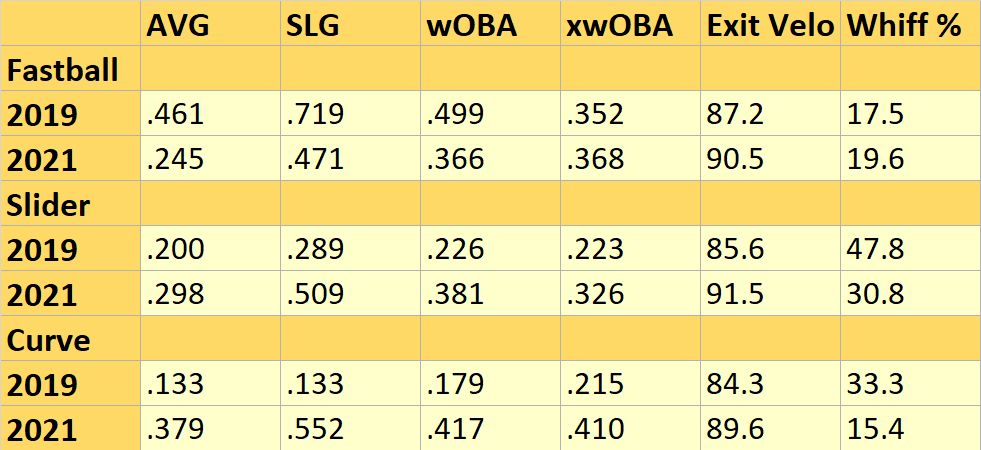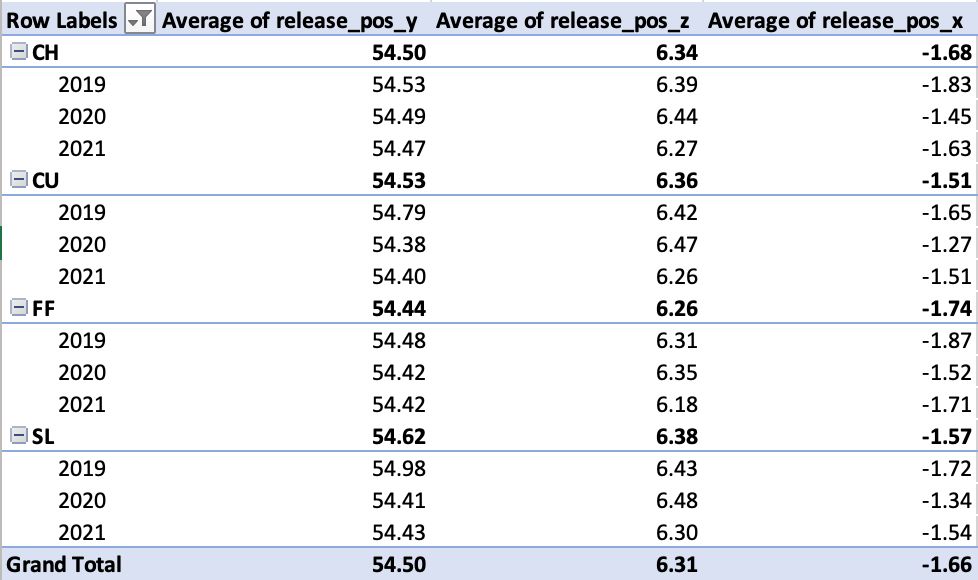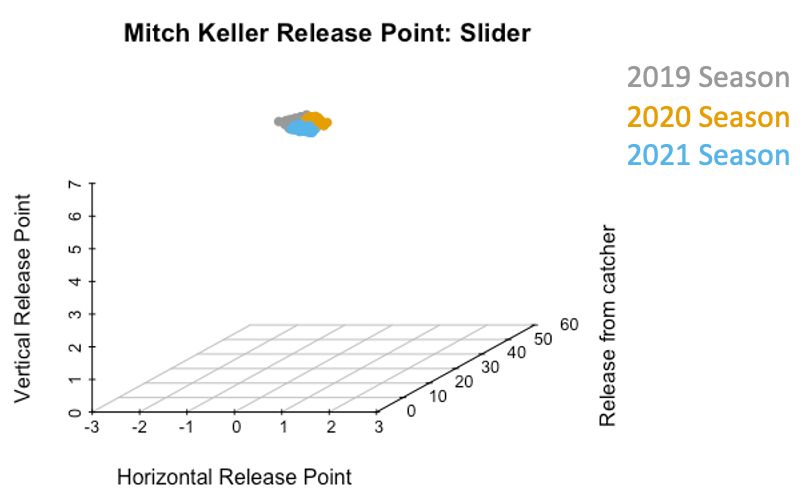WASHINGTON -- On Saturday, the Pirates did something that Derek Shelton had insisted wasn’t on the table just two days earlier.
They optioned Mitch Keller back to the minors.
The decision was justifiable. Keller had pitched to a 7.04 ERA over 47⅓ innings, averaging just four innings a start. He left breadcrumbs that he was figuring things out, alternating poor and good starts for the first two months of the season. The overall results obviously weren’t there, but it was a source of hope that he could break through.
That was until his last two innings. He lasted just two innings against the Marlins on June 4 before being removed with what the club called “heat illness.” After going through COVID-19 protocols after some symptoms lingered, he made his next scheduled start June 10, where he again failed to pitch out of the third.
Two days later, they made the change.
“It’s a tough move, but it’s a move that’s important for both Mitch and the Pirates,” Shelton said Saturday. “We need to get him in a situation where he’s commanding the fastball better, he’s doing things that are making him an effective big league pitcher. We really feel he’s going to be a good big league pitcher, but we’ve got to put him in a situation to do that.”
Keller came into this year with an inside track at being the opening day starter. He was supposed to take that step and lead the rotation. That hasn’t happened.
Keller’s ERA and inning total is nearly identical to his rookie year, 7.13 over 48 frames, but that doesn’t tell the whole story. Keller had the highest batting average allowed on balls in play (.475) in the history of baseball that rookie season. His FIP was nearly four runs lower (3.19) than his ERA, and his expected ERA -- going based off of exit velocity, launch angle and direction, strikeouts and walks -- was 2.76. Actual results go on the back of the baseball card, but the peripherals were strong and appeared to be a foundation for future success.
In the same amount of innings this year, he has a 4.94 FIP and 5.53 xERA. That’s better than his actual results, but knowing Keller’s ERA was supposed to just be around five wouldn’t do much to quell the concerns.
The reason for Keller’s struggles is a mystery. The most common theory is it’s a confidence issue, and while that could be part of it, there are other red flags that need addressed.
Let’s take a look.
THE PITCHES
In post-game Zoom calls after Keller starts, Shelton has almost always cited executing the fastball as the reason for his success or failure for that day. When things are going right, he’s succeeding primarily high in the strike zone with upper-90s heat, challenging and beating hitters.
Not to bury the lede, but that’s partly because his breaking stuff has regressed since his rookie year.
In 2019, his slider averaged 2,661 RPM of spin and his curve averaged 2,770 RPM. In 2021, those figures decreased to 2,403 RPM on the slider and 2,662 RPM on the curve. As far as the slider is concerned, if it hadn’t been previously established that it was a slider, pitch tracking would probably qualify it as a cutter.
The good news for the curve is that it doesn’t seem to have affected his movement that much. If anything, he’s getting more vertical drop because more of that spin is active spin. The reduced spin is more a problem for the slider, which isn’t getting as much drop or run as it did his rookie season.
Neither pitch is playing particularly well, though. None of them are, actually. Compare how each of his three primary pitches is performing compared to that rookie year:

I omitted 2020’s results because the sample size was so small and he really only had three starts at full strength. The peripherals definitely were closer to 2021 than 2019, though.
Keller’s fastball results his rookie year were pretty horrible, with a lot of that BABIP bad luck coming against that one pitch. The expected wOBA on his fastball from that season are very similar to what they are this year, though he’s walking more hitters now than he did then.
Coming up through the minors, Keller always had a good fastball, but it was never considered great. It had the velocity, but it didn’t move as much. The curveball was his best pitch, and once he started developing a slider in 2019, he had three legitimate pitches a show-me changeup. He could use his entire arsenal to try to get hitters out.
This year, he is pitching off of the fastball. He’s gone from throwing heat 48.1% of the time in 2019 to 57.2% this season. He’s going after hitters with fastballs early in the count more, and if he gets ahead, the breaking stuff really plays. If he falls behind, he has to rely on the fastball more, which only makes those poor results worse.
That’s only half of the problem with his pitches, though.
THE LOCATION
We’ve established that Keller has, traditionally, not gotten good results with his four-seamer.
Part of the reason why is where he is throwing it:
Don’t know which is worse for Mitch Keller. That he was putting his fastballs here, or that the SLG (.471) and wOBA (.366) against the fastball was the lowest out of his four pitches. pic.twitter.com/XgqnrhGQz5
— Alex Stumpf (@AlexJStumpf) June 12, 2021
You can see where he wants those pitches to land, either up in the zone or on the black to his glove side, giving it a little more run. The problem is he’s missing both locations far too often, and it’s hanging over the heart of the plate instead.
The same thing is happening to his breaking pitches. Compare his 2019 slider heat charts to 2021:
And the same for his curveball:
This chapter is pretty self-explanatory. He is leaving what should be his plus pitches in a position where hitters can still do damage. That slider should be hanging around that low, glove side corner more, if not actually fall off the plate. The curveball is supposed to drop in on his hand side.
This is where the drop in spin on the slider I think is the most pertinent. More movement would really play well here, either because it will land on the black of the strike zone more or it will get chases. Keller needs those whiffs, and he just isn’t getting them consistently.
Why?
THE MECHANICS
It’s time to get three-dimensional.
Back in April, I wrote about how important a consistent release is for Keller’s fastball. It’s worth noting that it’s coming in at a lower arm slot this year, too.
It turns out that’s not the only change Keller has had in his release. His arm is extending further on his breaking pitches. Through his career, Keller’s fastball extension was about 6 to 6.1 feet away from the mound. His curveball was 5.7 feet and his slider 5.5 feet in his rookie year, though, meaning it was leaving the hand sooner. Now, all three pitches are leaving at 6.1 feet. That’s a difference of about five inches on the curveball and seven on the slider. In a game of inches, that’s noteworthy.
Here's how his release has changed over his three years in the majors by pitch. The x-axis is horizontal (or distance away from his body), the z-axis is height and the y-axis is depth, or extension, all measured in feet:

It’s hard to make this into a three-dimensional chart, but hopefully this gets the point across:

The fact that all of the 2021 sliders are in front of the other years’ is what’s telling. Not only is it a different arm slot, it’s different depth. This is a good thing for perceived velocity, but consider this. Maybe Keller’s offspeed pitches are hanging over the heart of the plate more because their flight time has been cut down. It’s a shorter path, and when coupled with less spin, a pitch that would normally fall off the plate in 2019 instead hangs over the strike zone.
To be clear, this is a hypothesis, but there are three things that are unquestionably true. His stuff isn’t playing as well, it’s hanging over the plate more and he has made a mechanical change, whether intentional or not. More times than not, there is a connection.
WHAT COMES NEXT?
The million-dollar (well, potentially tens of millions of dollars) question is how does Keller right the ship? If you’re craving a Tyler Glasnow comparison, here’s the only one that matters: The Pirates can’t do to Keller what they did to Glasnow. His last year here, Glasnow was relegated to the bullpen, pitching mostly long relief and garbage time. There was no chance for him to develop in competition. One bad year and they pulled the plug. It’s the mistake that ultimately doomed the past regime.
Getting optioned is probably the best course of action for Keller. It will give him a low-pressure environment to try to correct whatever has been going wrong, whether it is mechanical, approach, psychological or in preparation. Maybe he should take a page out of Ray Searage’s book and experiment with a two-seamer. If he isn’t getting the whiffs he wants with the fastball, maybe a more pitch to contact approach could yield better results.
Back in spring training, Keller talked about how many of the organization’s pitching prospects were looking up to him. In a lot of ways, he was supposed to be the pitching equivalent to Ke’Bryan Hayes. Hayes was the first of the major hitting prospects to break through and will be welcoming those young position players to the majors in the coming years. Keller was supposed to do the same.
He’s not the first pitcher to get knocked down like this. The question is will he get back up.
